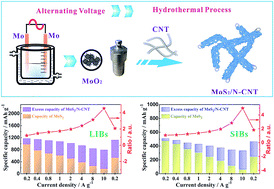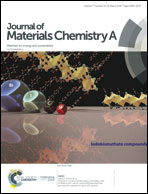Binding low crystalline MoS2 nanoflakes on nitrogen-doped carbon nanotube: towards high-rate lithium and sodium storage†
Abstract
Two-dimensional transition metal dichalcogenides are promising candidates for lithium-ion and sodium-ion batteries. It is becoming more meaningful to explore the effective preparation method of these materials and study their surface, interfacial, and chemical characteristics for energy storage. Herein, low crystalline MoS2 nanoflakes embedded on N-doped CNT (MoS2/N-CNT) have been designed utilizing Mo metal as the raw material through alternating current and hydrothermal technique. Through this approach, a strong interaction has been formed between the few layers of MoS2 nanoflakes and N-CNT via chemical bonds (C–O–Mo, C–S–Mo, and C–O–S), which can shorten the ion diffusion and electronic transmission paths and even maintain the structural integrity. Meanwhile, the expanded interlayers, doped N, and the many defects in MoS2/N-CNT further make it favorable for effective energy storage. Therefore, MoS2/N-CNT presents high specific capacity, ultra-long cycling stability (1003 mA h g−1 after 800 cycles at 2 A g−1), and excellent rate capacity for lithium-ion batteries. The electrode also shows similar sodium storage performance (the capacity is 4.97 times higher than that of pure MoS2 at 10 A g−1). These results provide a novel strategy to enhance the synergistic effect of layered transition metal dichalcogenide/carbon composites with unique structural properties, which is beneficial for lithium and sodium storage.



 Please wait while we load your content...
Please wait while we load your content...